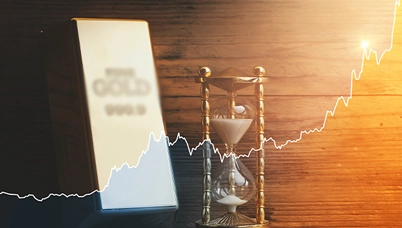Who has the Gold Now?
Posted On Thursday, Dec 22, 2011
As 2011 ends, two things are certain – a quick rewind of the main events that ruled 2011 and an outlook of what we can expect in the New Year. This also means speculations and arguments on the economy, including the most talked about element in our column - gold.
Considering gold’s exceptional fundamentals, it is no surprise that even to this day, its demand has stayed incredibly strong throughout the bull market. As magazines write columns on a rising star, many delve deep into the supply demand theories to predict gold’s next move. However, there is no assurance that these numbers or talks can influence gold’s prices beyond the short term.
Some argue that issues on the supply side are incredibly bullish for gold. While saying so, they naively ignore the existing 165, 000 tonnes of gold that remains hoarded. The yearly mine supply known to us, is just a small fractional addition to this hoarded gold.
The gold produced each year isn’t consumed. Instead, it gets added to the existing aboveground stock. Hence, the entire aboveground stock represents potential gold supply.
In this respect, gold acts more like a currency than a commodity. We will help put this into perspective: When a central bank creates new money, it becomes an indistinguishable part of the existing total supply. The total supply includes every currency created, but has not yet extinguished or destroyed, up until today. And, it is this total supply along with the demand for it that determines the dollar`s price.
In the gold market, it is rightly argued that not all the gold that comes into existence amounts to a ready supply force. However, the gold held for monetary and investment purposes can easily shape into potential supply. This would include gold held by central banks, private investments in form of gold bars, coins, ETFs, gold funds etc and would also include gold jewellery held for investment reasons. By all conservative estimates, the combined gold may probably be more than 100,000 tonnes. The annual mine production of about 2,500 tonnes constitutes a very small proportion, and logically it does not bear much influence on prices.
What matters then?
The decision by the hoarders to not part with their gold, keeps the supply side restrained. This probably leaves the mine supply along with the small and steady amount of gold changing hands through aboveground stock, to be termed as scrap / dishoarding. In addition, the hoarders absorb more of it than is added from the annual mine supply.
Why don’t the hoarders want to part away with their gold?
The answer to the above question is that, even though gold is not officially considered “money” today, it is still highly perceived as a form of currency. The long-term trends in gold prices are driven by changes in the overall level of confidence in the monetary system and economy. Such movements determine whether hoarders want to part with their gold, which would undermine its price, or if they want to purchase more of it, leading to a price rise.
It is important to keep a watch on such long-term trends, especially those related to the monetary policies practiced by governments across the globe, as well as the trends that involve buying behavior for gold. Such trends could provide insights into the investor’s participation, thus signaling periods when the market fundamentals turn into a speculative frenzy instead. Many fear that the current gold market has developed into a bubble. Such speculations however, are baseless as the macro-economic trends suggest that the current increases in prices are indeed logical.
A report by the World Gold Council titled "Gold Demand Trends" provides some insights into the gold buying trends for the third quarter of 2011, and highlights major buying trends that are shaping up across the years.
Gold reaching record high levels of $1900 for the first time was the biggest highlight for the quarter. Although the quarter ended on a positive note as compared to the previous quarter, the ensuing fall in gold prices towards the end do raise some eyebrows.
The gain in supply through increased mine output, at a time when there is a marked slowdown in the jewellery sales is an issue of concern. If the supply is increasing faster than its demand, why are gold prices rising?
The decline in demand must be viewed in entirety. It is true that the traditional form of gold demand has been declining. However, investors and central banks that consider hoarding gold in order to diversify and protect themselves against currency debasement in case the situation continues to deteriorate, have covered this gap. Diversification of reserves and investment in gold has been unfolding steadily as expected and is likely to continue over the next few years as well.
It is surprising to see many are still amazed at this increasing trend. They have also gone to the extent of explaining that speculative demand supports the gold rally. However, it seems they have gotten it completely wrong and have not understood gold dynamics completely.
The Indian Gold Market:
Let us try to look at some evolving trends in the gold market and nip some myths that may be budding in the investors’ minds.
India’s gold demand has indeed declined by -23% in the third quarter from its levels a year ago. However, Year-to-Date, numbers show that gold demand has been higher by +5% for the first three quarters as compared to last year, which in itself was a record. Demand for gold has fallen in the third quarter due to reasons like high volatility, sharp Rupee depreciation that contributed to higher domestic prices, and being a seasonally low period that included the period of ‘shardh’, which is considered inauspicious for buying gold.
India’s increase in total demand for gold this year seems to be driven entirely by investment demand. While jewellery demand has been flat, investment demand has increased by +15%. Some say that such higher investment demands are a form of speculation.
In India, there has always been a thin line between jewellery demand and investments. Maximum jewellery purchased is with intentions of wealth preservation and growth. A World Gold Council report states that “Motivation, rather than the form the purchase takes is key. In the last decade, 75% of gold demand in India has taken the form of jewellery. Our experience indicates that more than 50% of this buying is motivated by investment-related principles.”
Prior to 1991, gold could only be held in the form of jewellery. This constraint has transformed into a buying behavior, which can be termed as tradition. Liberalisation however, brought with it major changes in the regulations governing the purchase and ownership of gold. Slowly and steadily, the market started shifting its base into more efficient ways of owning gold. The fact that most of the gold purchased is close to the 24 carat mark also supports the notion that it is positioned towards investments.
The composition change hints at markets moving towards efficiency

Note: Gold demand refers to jewellery fabrication, investment and other demand
Source: GFMS, Source: World Gold Council
The graph above shows how investors are now moving towards other means of owning gold, other than only jewellery . The overall trends in the gold market and a few of these quarterly events are in line with long term trends. Let us take jewellery as an example: in the long run, jewellery purchase has been declining from the overall gold demand. This is well known in the gold market. On the other hand, the share of investment in gold has been on a rise as a proportion of tonnage and value. The trend is likely to continue going forward as well. The introduction of efficient products like Gold ETFs will only further increase the investment trend as markets move towards efficiency.
Gold is moving into strong hands:
There has been a big shift in demand from the West to the East. According to the latest World Gold Council (WGC) report, in 1970, half of the world’s gold was purchased in two regions—North America and Europe. Ten years later, that figure jumped to 68% due to high inflation, weak economy and a spike in gold prices. At the same time, China and India saw their combined share of gold demand diminish from 35% to 15%. The WGC report states that North America and Europe had a 47% combined share of the global gold market in 1970, which grew to 68% by 1980. It however fell to 38% in 1990, 28% in 2000 and 27% in 2010. In the meantime, the Indian sub-continent and East Asia’s share rose from 35% in 1970 to 58% by 2010.
India and China have been rising as the largest consumers of jewellery, and there are now markets in the western countries where recycling of gold is actually higher on a quarterly basis, than new jewellery demand. This shows that in OECD countries, for example, where incomes are under pressure, economic growth is slow. High unemployment exists and thus the demand for jewellery is very poor. In China and India however, there has been continued strong economic growth, which lead to a rise in household wealth and hence drove the demand for jewellery higher. India and China now hold over 52% of the world’s jewellery demand, and together, they control over 48% of total demand for gold. This trend has developed steadily, and is set to continue for many years ahead.
While the accumulation of physical gold rolls on in Asia, the underlying bid for gold is spreading across the globe.
Get accustomed to higher prices:
Volatility has a great impact on gold, particularly on the jewellery market. The Indian demand for gold jewellery declined 26% year-on-year points to the fact of demand being extremely price sensitive and more so if it is due to volatility. Investors do not have a problem with high prices as long as the prices are stable. While comparing 2010 with the first part of 2011, it is apparent that Asian consumers have become more accustomed to higher gold prices provided it is a gradual rise in price and an uptrend. In previous years, you would have seen that as the gold price rose, consumers would shy away from making new purchases. However, this was not the occurrence in 2010 and this has not happened in India and China either for a large part of this year.
China fires ahead on all cylinders:
While India is likely to remain the largest gold market in the world in terms of tonnage and value, China will have closed the gap yet again. Chinese jewellery demand was actually higher than Indian jewellery demand in this quarter, and that is another noticeable result. Chinese currency is pegged at or rather saw minor appreciation vis-a-vis the Dollar and hence did not witness as much volatility or appreciation in gold prices as was seen in the Indian markets because of a sharp Rupee depreciation. Chinese demand has witnessed a steady growth since China opened its gold market, and experts suggest that the demand for gold will continue to grow at this pace for at least a few years. They say that China’s thirst for gold is unquenchable.
Europe gears up as well:
Gold investment demand was very strong in the third quarter of 2011. Although the total gold demand was only up by about 6%, gold investment demand was up 23% in the quarter. It was a good quarter for gold ETFs as well; we saw new investment of 77.6 tonnes. However, the figure that really stood out was a very high gold bar and coin investment in Europe totaling 118 tonnes, which was somewhat driven by the Euro zone debt crisis. That was bigger than the bar and coin demand in India and China, which is a rather a rare occurrence.
We need to go back to early 2010 to see another quarter where European investment was bigger than India or China and this has only taken place about four or five times in the last seven years. Obviously, the Greek debt crisis and the continuous evolution of the Euro zone debt crisis was a big motive as investors looked to preserve their wealth against depreciating currencies and were concerned about a possible breakup of the Euro zone.
The mystery buyer appears:
The lack for gold’s demand created because of a decline in jewellery off take balanced itself when the official sector swooped in to secure a net haul of almost 150 tonnes in the third quarter of 2011. It is the highest level recorded since central banks became net buyers of gold in the second quarter of 2009, after two decades of net sales. The report attributed 15 tonnes of the purchases to Russia, 14 tonnes to Bolivia and 25 tonnes to Thailand. While it openly states that a number of countries’ central banks have made other major purchases, it said that they “cannot currently be identified due to confidentiality restrictions.” The buyers remain a big-budget mystery.
The possible reasons we reckon for the confidentiality is because the central bank is looking to buy more gold and hence does not want to be named as it could have direct consequences in terms of prices moving higher before it completes all its buying. News flows of certain central banks like China and India can have a significant positive impact on gold prices as they serve as confidence boosters and reiterate the currency issues due to which gold is rolling higher.
Driving down the point:
The article has tried to highlight the major trends in the gold market and address certain misconceptions, which prevail in the minds of gold investors.
Here is a quick summary of the key points from the article:
i) A significant geographical shift in demand towards consumption and investment in gold has occurred in the last few decades. This is akin to moving power into strong hands, as these are nations have powerful social, cultural and religious pull towards gold.
ii) Current trends in the form of increased investment demand would continue, as markets move towards efficiency. Only the form of buying changes while the motive remains the same.
iii) Ideas that Western institutional investors primarily determine prices are a “common misconception”, although this may sometimes occur in the short term, based on the size of individual trades.
iv) Gold is still perceived as a monetary asset and as a currency. In these hard times, we see a lot of value in it as an effective diversifier in portfolios of more traditional assets. The issues surrounding currency debasement and its adverse long run consequences are still acting as the biggest drivers of gold.
v) The ongoing theme of diversification of reserves and investments in gold has been unfolding steadily and is likely continue in the future as well.
Gold prices are on the rise with the intention of reclaiming its rightful place; as a response to the monetary abuse occurring due to the intentional actions of current policymaking. Gold will also act as a potential shield over the ambitions and plans of the "best-and-the-brightest" in fields of banking, academia, and government.
Note: The sources for the above information are Bloomberg and World Gold Council.
Disclaimer:
The views expressed in this article are the personal views of the Fund Manager of Quantum Gold Fund. The views constitute only the opinions and do not constitute any guidelines or recommendation on any course of action to be followed by the reader. This information is meant for general reading purpose only and is not meant to serve as a professional guide/investment advice for the readers. This article has been prepared on the basis of publicly available information, internally developed data and other sources believed to be reliable. Readers are advised to seek independent professional advice and arrive at an informed investment decision before making any investments. Please visit – www.quantumamc.com/disclaimer to read scheme specific risk factors.
Related Posts
-

Equity Monthly for January 2026
Posted On Friday, Jan 02, 2026
Indian markets remained range-bound in 2025
Read More -

Gold Monthly for January 2026
Posted On Thursday, Jan 01, 2026
Gold Market Review and Outlook: 2025–2026
Read More -

Debt Monthly for January 2026
Posted On Thursday, Jan 01, 2026
Navigating 2026: India’s Bond Market in a Changing Global Landscape
Read More



